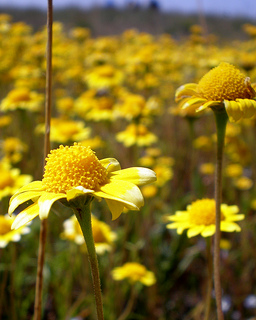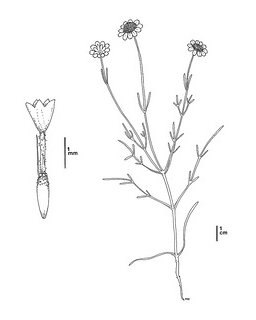 Lasthenia burkei. CDFW Photo by Patrick Moeszinger.
Lasthenia burkei. CDFW Photo by Patrick Moeszinger.
 Lasthenia burkei. CDFW illustration by Mary Ann Showers. (Click to enlarge)
Lasthenia burkei. CDFW illustration by Mary Ann Showers. (Click to enlarge)
Burke’s goldfields is listed as a California endangered plant species, which means that killing or possessing the plant is prohibited by the California Endangered Species Act (CESA). The species is also listed as endangered under the federal Endangered Species Act. Burke’s goldfields is a small annual herb that grows in vernal pools and swales. Most occurrences have been found in the Santa Rosa Plain area of Sonoma County, but population records also exist from Napa, Lake, and Mendocino Counties. At the time of this webpage posting, the California Natural Diversity Database reported 28 occurrences of this species that are presumed to still exist, however many of these occurrences have not been observed in several years. Burke’s goldfields sometimes occurs with Sonoma sunshine (Blennosperma bakeri) or Sebastopol meadowfoam (Limnanthes vinculans), which are also listed as endangered under CESA and the federal Endangered Species Act.
Populations of vernal pool plants such as Burke’s goldfields are typically discontinuous and fragmented due to differences in climate, substrate, and topography, and are often restricted to very specific habitats and locations. These factors, coupled with urbanization and the conversion of land for agriculture, endanger many California vernal pool species with extinction. The biggest threat to Burke’s goldfields continues to be urban development and conversion of land to viticulture or other intensive land uses, and the resulting habitat fragmentation. Burke’s goldfields is also sensitive to land use changes that cause variations in hydrology and the duration of vernal pool inundation. Burke’s goldfields is threatened by increased runoff, frequent disking of land, breaking of the vernal pool hardpan, and activities that allow competing plant species to become established. Other threats include manipulation of normal gene flow resulting from restoration work, buildup of thatch in previously grazed areas, and the effects of climate change.
Although work has already begun to conserve this species, further action is necessary to aid conservation of Burke’s goldfields. Remaining natural populations of Burke’s goldfields should be protected and new populations should be established that do not negatively affect existing natural populations. Non-native plant species that compete with Burke’s goldfields should be managed, and effective weed eradication measures that do not harm Burke’s goldfields should be researched. Populations of Burke’s goldfields should be monitored using standardized protocols, and research into the habitat requirements, reproductive ecology, gene flow, seed bank dynamics, and the long-term viability of restoration sites should be conducted.
CDFW has participated in the following Burke’s goldfields studies and papers with funding through the Cooperative Endangered Species Conservation Fund or other mechanisms:
CDFW may issue permits for Burke’s goldfields pursuant to CESA, and you can learn more about the California laws protecting Burke’s goldfields and other California native plants. Populations of Burke’s goldfields occur in CDFW’s Bay Delta Region. More information is also available from the U.S. Fish and Wildlife Service Species Profile for Burke’s goldfields.
Updated 6/24/14